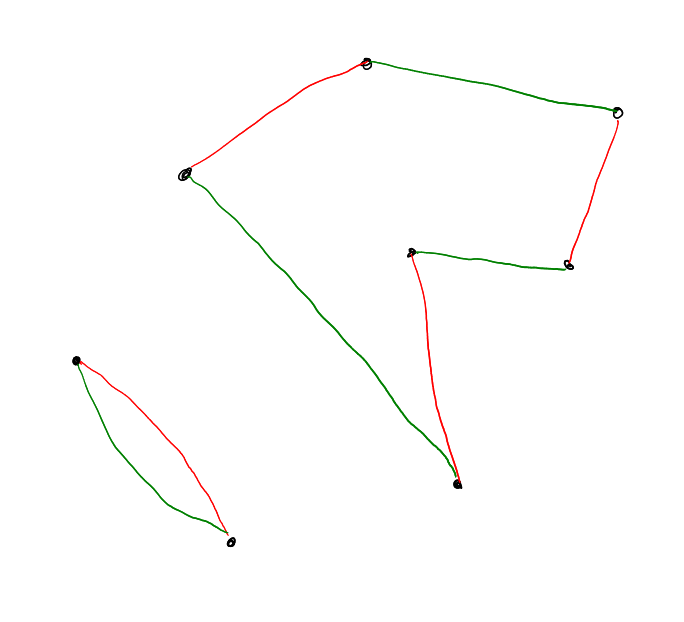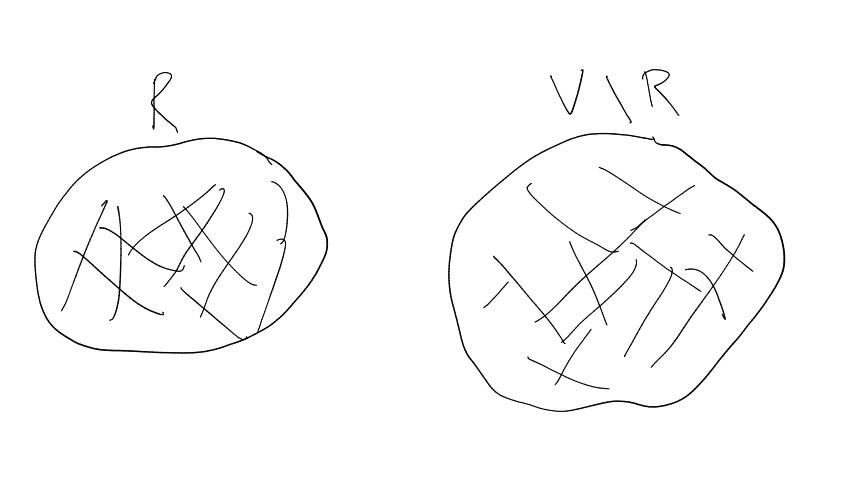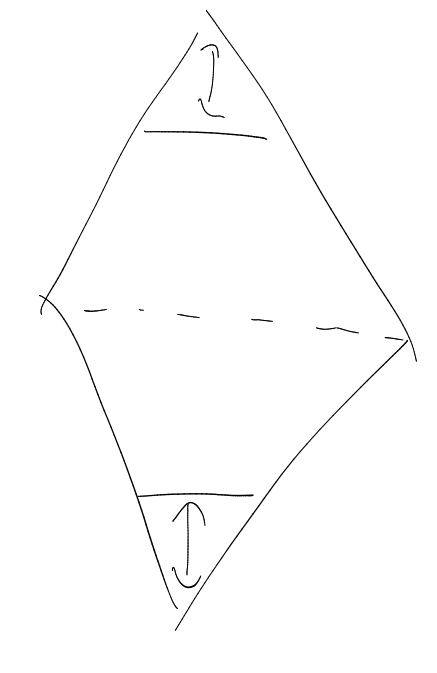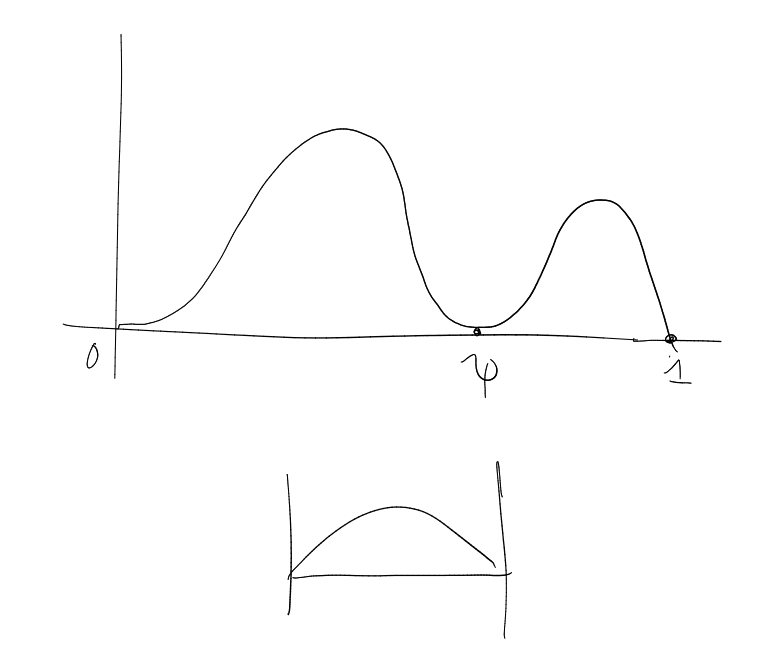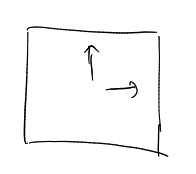Entropy Methods in
Combinatorics
Lectured by Timothy Gowers
Contents
1 The Khinchin (Shannon?) axioms for entropy
Note.
In this course, “random variable” will mean “discrete random variable” (unless otherwise
specified).
All logarithms will be base
(unless otherwise specified).
Definition (Entropy).
The entropy of a discrete random variable
is a
quantity
that takes real values and has the following properties:
-
(i)
Normalisation: If
is uniform on
then .
-
(ii)
Invariance: If
takes values in ,
takes values in ,
is a bijection from
to ,
and for every
we have ,
then .
-
(iii)
Extendability: If
takes values in a set ,
and
is disjoint from ,
takes values in ,
and for all
we have ,
then .
-
(iv)
Maximality: If
takes values in a finite set
and
is uniformly distributed in ,
then .
-
(v)
Continuity:
depends continuously on
with respect to total variation distance (defined by the distance between
and
is ).
For the last axiom we need a definition:
Let and
be random variables.
The conditional entropy
of given
is
-
(vi)
Additivity: .
Lemma 1.1.
Assuming that:
Proof.
.
Since and
are independent, the
distribution of is
unaffected by knowing
(so by invariance, ),
so
for all ,
which gives the result. □
Corollary 1.2.
If
are independent, then
|
|
Proof.
Lemma 1.1 and obvious induction. □
Lemma 1.3 (Chain rule).
Assuming that:
Then |
|
Proof.
The case
is additivity. In general,
|
|
so we are done by induction. □
Lemma 1.4.
Assuming that:
Proof.
The map is
a bijection, and .
So the first statement follows by invariance. For the second statement:
Lemma 1.5.
Assuming that:
Then .
Proof.
and
are independent. Therefore, by Lemma 1.1, .
But by invariance, .
So .
□
Proposition 1.6.
Assuming that:
Then .
Proof.
Let
be independent random variables uniformly distributed on .
By Corollary 1.2 and normalisation, .
But
is uniformly distributed on ,
so by invariance, the result follows. □
Proposition 1.7.
Assuming that:
Then .
Reminder: here
is to the base
(which is the convention for this course).
Proof.
Let
be a positive integer and let
be independent copies of .
Then is
uniform on
and
Now pick
such that .
Then by invariance, maximality, and Proposition 1.6, we have that
So
|
|
Therefore,
as claimed. □
Notation.
We will write .
We will also use the notation .
Theorem 1.8 (Khinchin).
Assuming that:
Then |
|
Proof.
First we do the case where all
are rational (and then can finish easily by the continuity axiom).
Pick
such that for all ,
there is some
such that .
Let be uniform
on . Let
be a partition
of into sets with
. By invariance we
may assume that .
Then
Hence
|
|
By continuity, since this holds if all
are rational, we conclude that the formula holds in general. □
Corollary 1.9.
Assuming that:
Then
and .
Proof.
Immediate consequence of Theorem 1.8. □
Corollary 1.10.
Assuming that:
Then .
Proof.
.
But .
□
Proposition 1.11 (Subadditivity).
Assuming that:
Then .
Proof.
Note that for any two random variables
we have
Next, observe that
if is
uniform on a finite set. That is because
By the equivalence noted above, we also have that
if
is
uniform.
Now let and assume
that all are
rational. Pick such
that we can write
with each an
integer. Partition
into sets of
size . Let
be uniform on
. Without loss of generality
(by invariance) .
Let for each
. So
. Now define a
random variable
as follows: If ,
then , but then
is uniformly
distributed in and
independent of
(or if
you prefer).
So and
are conditionally
independent given ,
and is
uniform on .
Then
By continuity, we get the result for general probabilities. □
Corollary 1.12.
Assuming that:
Then .
Proof (Without using formula).
By Subadditivity, .
But .
□
Corollary 1.13.
Assuming that:
Then |
|
Proposition 1.14 (Submodularity).
Assuming that:
Proof.
Calculate:
Submodularity can be expressed in many ways.
Expanding using additivity gives the following inequalities:
Lemma 1.15.
Assuming that:
-
random variables
-
Proof.
Lemma 1.16.
Assuming that:
-
random variables
-
Then |
|
Proof.
Submodularity says:
|
|
which implies the result since
depends on
and .
□
Lemma 1.17.
Assuming that:
Then is
uniform.
Proof.
Let .
Then
The function
is concave on .
So, by Jensen’s inequality this is at most
|
|
Equality holds if and only if
is constant – i.e.
is uniform. □
Corollary 1.18.
Assuming that:
-
random variables
-
Then
and are
independent.
Proof.
We go through the proof of Subadditivity and check when equality holds.
Suppose that
is uniform on .
Then
with equality if and only if
is uniform on for all
(by Lemma 1.17),
which implies that
and are
independent.
At the last stage of the proof we used
|
|
where was uniform. So
equality holds only if
and are independent,
which implies (since
depends on )
that
and are
indpendent. □
Definition (Mutual information).
Let
and be random variables.
The mutual information
is
Subadditivity is equivalent to the statement that
and Corollary 1.18 implies that
if and only if
and are
independent.
Note that
|
|
Definition (Conditional mutual information).
Let
,
and
be random variables. The
conditional mutual information of
and
given ,
denoted by
is
Submodularity is equivalent to the statement that
.
2 A special case of Sidorenko’s conjecture
Let be a bipartite
graph with vertex sets
and (finite)
and density
(defined to be ).
Let
be another (think of it as ‘small’) bipartite graph with vertex sets
and
and
edges.
Now let and
be random functions.
Say that is a
homomorphism if
for every .
Sidorenko conjectured that: for every ,
we have
|
|
Not hard to prove when
is . Also not hard
to prove when
is (use
Cauchy Schwarz).
Theorem 2.1.
Sidorenko’s conjecture is true if
is a path of length .
Proof.
We want to show that if
is a bipartite graph of density
with vertex sets
of size and
and we
choose ,
independently at random, then
|
|
It would be enough to let
be a P3 chosen uniformly at random and show that .
Instead we shall define a different random variable taking values in the set of all P3s (and then apply
maximality).
To do this, let
be a random edge of
(with ,
).
Now let
be a random neighbour of
and let
be a random neighbour of .
It will be enough to prove that
|
|
We can choose
in three equivalent ways:
-
(1)
Pick an edge uniformly from all edges.
-
(2)
Pick a vertex
with probability proportional to its degree ,
and then pick a random neighbour
of .
-
(3)
Same with
and
exchanged.
It follows that
with probability ,
so is
uniform in ,
so with
probability ,
so is
uniform in .
Therefore,
So we are done my maximality.
Alternative finish (to avoid using !):
Let be uniform in
and independent
of each other and .
Then:
So by maximality,
3 Brégman’s Theorem
Definition (Permanent of a matrix).
Let
be an matrix
over . The
permanent of ,
denoted , is
i.e. “the determinant without the signs”.
Let be a bipartite
graph with vertex sets
of size .
Given ,
let
|
|
ie is the bipartite
adjacency matrix of .
Then is the number of
perfect matchings in .
Brégman’s theorem concerns how large
can be if is a
-matrix and the sum
of entres in the -th
row is .
Let be a disjoint
union of s
for ,
with .
Then the number of perfect matchings in
is
Theorem 3.1 (Brégman).
Assuming that:
Then the number of perfect matchings in
is at most
Proof (Radhakrishnan).
Each matching corresponds to a bijection
such
that for
every .
Let be
chosen uniformly from all such bijections.
|
|
where
is some enumeration of .
Then
where
|
|
In general,
|
|
where
|
|
Key idea: we now regard
as a random enumeration of
and take the average.
For each , define
the contribution of
to be
where
(note that this “contribution” is a random variable rather than a constant).
We shall now fix . Let
the neighbours of
be .
Then one of the
will be , say
. Note that
(given
that ) is
|
|
All positions of are equally likely,
so the average contribution of
is
|
|
By linearity of expectation,
|
|
so the number of matchings is at most
Definition (-factor).
Let
be a graph with
vertices. A -factor
in
is a collection of
disjoint edges.
Theorem 3.2 (Kahn-Lovasz).
Assuming that:
Then the number of
-factors
in
is at
most
|
|
Proof (Alon, Friedman).
Let
be the set of -factors
of , and let
be a uniform
random element of .
For each ,
the union
is a collection of disjoint edges and even cycles that covers all the vertices of
.
Call such a union a cover of
by edges and even cycles.
If we are given such a cover, then the number of pairs
that could give
rise to it is ,
where
is the number of even cycles.
Now let’s build a bipartite graph
out of .
has two vertex
sets (call them ),
both copies of .
Join to
if and
only if .
For example:
By Brégman, the number of perfect matchings in
is . Each matching
gives a permutation
of , such
that for
every .
Each such has a cycle decomposition,
and each cycle gives a cycle in .
So gives a
cover of
by isolated vertices, edges and cycles.
Given such a cover with
cycles, each edge can be directed in two ways, so the number of
that give
rise to is is ,
where
is the number of cycles.
So there is an injection from
to the set of matchings of ,
since every cover by edges and even cycles is a cover by vertices, edges and cycles.
So
|
|
4 Shearer’s lemma and applications
Notation.
Given a random variable
and with
, write
for the random
variable .
Lemma 4.1 (Shearer).
Assuming that:
-
a random variable
-
a family of subsets of
such that every
belongs to at least
of the sets
Then |
|
Proof.
For each ,
write
for .
For each ,
with
, we
have
Therefore,
Alternative version:
Lemma 4.2 (Shearer, expectation version).
Assuming that:
-
a random variable
-
a randomly chosen subset of ,
according to some probability distribution (don’t need any independence conditions!)
-
for each ,
Proof.
As before,
So
Definition ().
Let
and let .
Then we write
for the set of all
such that there exists
such that ,
where
is
suitably intertwined with
(i.e.
as functions).
Corollary 4.3.
Assuming that:
Proof.
Let be a uniform
random element of .
Then by Shearer,
But tkaes
values in ,
so
so
|
|
If we
get
|
|
This case is the discrete Loomis-Whitney theorem.
Theorem 4.4.
Assuming that:
Then has
at most
triangles.
Is this bound natural? Yes: if , and
we consider a complete graph on
vertices, then we get approximately
triangles.
Proof.
Let
be a random ordered triangle (without loss of generality
has a triangle so that this is possible).
Let be the number
of triangles in .
By Shearer,
|
|
Each edge is supported
in the set of edges ,
given a direction, i.e.
|
|
Definition.
Let
be a set of size
and let
be a set of graphs with vertex set .
Then
is -intersecting
(read as “triangle-intersecting”) if for all ,
contains a triangle.
Theorem 4.5.
Assuming that:
Then has size
at most .
Proof.
Let
be chosen uniformly at random from .
We write
for the set of (unordered) pairs of elements of .
Think of any
as a function from
to .
So .
For each ,
let be the
graph
For each , we shall look at the
projection , which we can think
of as taking values in the set .
Note that if ,
, then
, since
contains a triangle,
which must intersect
by Pigeonhole Principle.
Thus, is an intersecting
family, so it has size at most .
By Shearer, expectation version,
Definition (Edge-boundary).
Let
be a graph and let .
The edge-boundary
of
is the set of edges
such that .
If
or
and ,
then the -th
boundary
is the set of edges
such that ,
i.e.
consists of deges pointing in direction .
Theorem 4.6 (Edge-isoperimetric inequality in ).
Assuming that:
Then .
Proof.
By the discrete Loomis-Whitney inequality,
But
since each fibre contributes at least 2.
So
Theorem 4.7 (Edge-isoperimetric inequality in the cube).
Assuming that:
Then .
Proof.
Let be a uniform
random element of
and write .
Write
for . By
Shearer,
Hence
Note
|
|
The number of points of the second kind is ,
so .
So
Also, .
So we are done. □
Definition (Lower shadow).
Let
be a family of sets of size .
The lower shadow
is .
Notation.
Let
(for ).
Theorem 4.8 (Kruskal-Katona).
Assuming that:
Then .
Proof.
Let
be a random ordering of the elements of a uniformly random
. Then
Note that is an ordering
of the elements of some ,
so
|
|
So it’s enough to show
|
|
Also,
|
|
and
|
|
We would like an upper bound for . Our
strategy will be to obtain a lower bound for
in terms of .
We shall prove that
|
|
Let be chosen
independently of
with
|
|
(
will be chosen and optimised later).
Given ,
let
|
|
Note that and
have the same
distribution (given ),
so does
as well. Then
where
and .
It turns out that this is maximised when .
Then we get
|
|
This proves the claim.
Let .
Then
Since ,
it follows that
|
|
It follows that
5 The union-closed conjecture
Definition (Union-closed).
Let
be a (finite) family of sets. Say that
is union closed if for any ,
we have .
Conjecture.
If is a non-empty
union-closed family, then there exists
that belongs to at least
sets in .
Theorem (Justin Gilmer).
There exists
such that if is a union-closed
family, then there exists
that belongs to at least
of the sets in .
Justin Gilmer’s constant was about .
His method has a “natural barrier” of .
We will briefly and “informally” discuss this.
A reason for this is that if we weaken the property union-closed to “almost union-closed” (if
we pick two elements randomly, then with high probability the union is in the family), then
is the
right bound.
Let . With high
probability, if are
random elements of ,
then .
If then almost
all of is
.
One of the roots of the quadratic
is .
If we want to prove Justin Gilmer’s Theorem, it is natural to let
be independent uniformly
random elements of
and to consider .
Since is
union-closed, , so
. Now we would like to
get a lower bound for
assuming that no
belongs to more than
sets in .
|
|
Lemma 5.1.
Assuming that:
Then .
Proof.
Think of as
characteristic functions. Write
for etc. By the Chain rule it is
enough to prove for every
that
|
|
By Submodularity,
|
|
For each
write ,
.
Then
|
|
which by hypothesis is at least
|
|
So
|
|
But
|
|
and
|
|
Similarly for the other term, so the RHS equals
|
|
which by hypothesis is greater than
|
|
as required. □
This shows that if is
union-closed, then ,
so . Non-trivial
as long as .
We shall obtain . We start by proving
the diagonal case – i.e. when .
Lemma 5.2 (Boppana).
For every ,
Proof.
Write
for .
Then ,
so and
, so
. Equality
also when .
Toolkit:
Let .
Then
So
This is zero if and only if
|
|
which simplifies to
|
|
Since this is a cubic with negative leading coefficient and constant term, it has a negative root, so it has at most two roots in
. It follows (using Rolle’s
theorem) that has at
most five roots in ,
up to multiplicity.
But
|
|
So , so
has a double
root at .
We can also calculate (using ):
So there’s a double root at .
Also, note .
So is either
non-negative on all of or
non-positive on all of .
If is
small,
so there exists
such that .
□
Lemma 5.3.
The function
is minimised on
at a point where .
Proof.
We can extend continuously
to the boundary by setting
whenever
or is
or
. To see this, note first
that it’s valid if neither
nor is
.
If either
or is
small, then
So it tends to
again.
One can check that ,
so is minimised
somewhere in .
Let be a
minimum with .
Let and
note that
|
|
Also,
|
|
with equality at . So the partial
derivatives of LHS are both
at .
So . So it’s enough
to prove that is
an injection. ,
so
Differentiating gives
|
|
The numerator differentiates to , which
is negative everywhere. Also, it equals
at . So
it has a constant sign. □
Combining this with Lemma 5.2, we get that
|
|
This allows us to take .
6 Entropy in additive combinatorics
We shall need two “simple” results from additive combinatorics due to Imre Ruzsa.
Definition (Sum set / difference set / etc).
Let
be an abelian group and let .
The sumset
is the set .
The difference set
is the set .
We write
for ,
for ,
etc.
Definition (Ruzsa distance).
The Ruzsa distance
is
Lemma 6.1 (Ruzsa triangle inequality).
.
Proof.
This is equivalent to the statement
|
|
For each ,
pick ,
such
that .
Define a map
Adding the coordinates of
gives , so we
can calculate
(and ) from
, and hence
can calculate .
So is an
injection. □
Lemma 6.2 (Ruzsa covering lemma).
Assuming that:
-
an abelian group
-
finite subsets of
Then can be
covered by at most
translates of .
Proof.
Let
be a maximal subset of
such that the sets
are disjoint.
Then if ,
there exists
such that .
Then .
So can be
covered by
translates of .
But
|
|
Let ,
be discrete random variables taking values in an abelian group. What is
when
and
are
independent?
For each ,
.
Writing
and for
and
respectively,
this givesim
where
and .
So, sums of independent random variables
convolutions.
Definition (Entropic Ruzsa distance).
Let
be an abelian group and let ,
be
-valued random variables.
The entropic Ruzsa distance
is
|
|
where ,
are independent copies of
and .
Lemma 6.3.
Assuming that:
-
,
are finite subsets of
-
,
are uniformly distributed on ,
respectively
Proof.
Without loss of generality ,
are
indepent. Then
Lemma 6.4.
Assuming that:
Then |
|
Proof.
By symmetry we also have
|
|
Corollary.
Assuming that:
Then:
|
|
Corollary 6.5.
Assuming that:
Proof.
Without loss of generality ,
are independent.
Then ,
so
Lemma 6.6.
Assuming that:
Then if and only if there
is some (finite) subgroup
of such that
and
are uniform
on cosets of .
Proof.
-
If ,
are uniform
on ,
, then
is uniform
on ,
so
|
|
So .
-
Suppose that ,
are independent and .
From the first line of the proof of Lemma 6.4, it follows that
. Therefore,
and
are independent.
So for every
and every ,
|
|
where ,
, i.e. for
all ,
|
|
So
is constant on .
In particular, .
By symmetry, .
So
for any .
So for every ,
,
,
so .
So
is the same for every .
Therefore,
for every .
It follows that
|
|
So
is a subgroup. Also, ,
so
is a coset of .
,
so
is also a coset of .
□
Recall Lemma 1.16: If ,
then:
|
|
Lemma 6.7 (The entropic Ruzsa triangle inequality).
Assuming that:
Then |
|
Proof.
We must show that (assuming without loss of generality that
,
and
are
independent) that
|
|
i.e. that
|
|
Since is a function
of and is also
a function of ,
we get using Lemma 1.16 that
|
|
This is the same as
|
|
By independence, cancelling common terms and Subadditivity, we get ().
□
Lemma 6.8 (Submodularity for sums).
Assuming that:
Then |
|
Proof.
is a
function of and
also a function of .
Therefore (using Lemma 1.16),
|
|
Hence
|
|
By independence and cancellation, we get the desired inequality. □
Lemma 6.9.
Assuming that:
Proof.
Let ,
,
be independent
copies of .
Then
(as are all
copies of ).
□
Corollary 6.10.
Assuming that:
Proof.
Conditional Distances
Definition (Conditional distance).
Let
be -valued random
variables (in fact,
and don’t have
to be -valued
for the definition to make sense). Then the conditional distance is
|
|
The next definition is not completely standard.
Definition (Simultaneous conditional distance).
Let
be
-valued random variables. The
simultaneous conditional distance of
to given
is
|
|
We say that ,
are conditionally
independent trials of ,
given
if:
-
is distributed like .
-
is distributed like .
-
For each ,
is distributed like ,
-
For each ,
is distributed like .
-
and
are independent.
Then
|
|
(as can be seen directly from the formula).
Lemma 6.11 (The entropic BSG theorem).
Assuming that:
Then |
|
Remark.
The last few terms look like .
But they aren’t equal to it, because
and
aren’t (necessarily) independent!
Proof.
|
|
where ,
are conditionally
independent trials of ,
given
. Now
calculate
Similarly, is
the same, so
is also the same.
|
|
Let and
be conditionally
independent trials of
given .
Then .
By Submodularity,
Finally,
Adding or subtracting as appropriate all these terms gives the required inequality. □
7 A proof of Marton’s conjecture in
We shall prove the following theorem.
Theorem 7.1 (Green, Manners, Tao, Gowers).
There is a polynomial
with the following
property:
If and
is such that
, then there is a
subspace of size at
most such that
is contained in the union
of at most translates
of . (Equivalently,
there exists ,
such
that ).
This is known as “Polynomial Freiman–Ruzsa”.
In fact, we shall prove the following statement.
Theorem 7.2 (Entropic Polynomial Freiman–Ruzsa).
There exists an absolute constant
satisfying the
following: Let
and let be
-valued random variables.
Then there exists a subsgroup
of such
that
|
|
where is the uniform
distribution on .
Lemma 7.3.
Assuming that:
Then there exists
such that .
Proof.
If not, then
|
|
contradiction. □
Proposition 7.4.
Theorem 7.2 implies Theorem 7.1.
Proof.
Let ,
. Let
and
be independent
copies of . Then by
Theorem 7.2, there exists
(a subgroup) such that
|
|
so
But
So .
Therefore
Therefore, by Lemma 7.3, there exists
such that
|
|
But
|
|
(using characteristic 2). So there exists
such that
|
|
Let . By the Ruzsa covering
lemma, we can cover
by at most
translates of .
But so
, so
can be covered
by at most
translates of .
But using ,
So
|
|
Since is
contained in ,
so , so
|
|
If then we are done.
Otherwise, since ,
so .
Pick a subgroup
of of size
between
and . Then
is a union
of at most
translates of ,
so is a union
of at most
translates of .
□
Now we reduce further. We shall prove the following statement:
Theorem 7.5 (EPFR).
There is a constant
such that if and
are any two
-valued random
variables with , then
there exists -valued
random variables
and
such that
|
|
Proof.
By compactness we can find ,
such
that
|
|
is minimised. If
then by EPFR()
there exist ,
such that .
But then
Contradiction.
It follows that .
So there exists
such that and
are uniform
on cosets of ,
so
|
|
which gives us EPFR().
□
Definition.
Write
for
|
|
Definition.
Write
for
|
|
Remark.
If we can prove EPFR
for conditional random variables, then by averaging we get it for some pair of random variables (e.g. of the
form
and ).
Lemma 7.7 (Fibring lemma).
Assuming that:
Then |
|
Proof.
But the last line of this expression equals
|
|
We shall be interested in the following special case.
Corollary 7.8.
Assuming that:
Then
Proof.
Apply Lemma 7.7 with ,
and .
□
We shall now set .
Recall that Lemma 6.11 says
|
|
Equivalently,
|
|
Applying this to the information term (),
we get that it is at least
which simplifies to
So Corollary 7.8 now gives us:
Now apply this to ,
and
and
add.
We look first at the entropy terms. We get
where we made heavy use of the observation that if
are some
permutation of ,
then
|
|
This also allowed use e.g. to replace
|
|
by
|
|
Therefore, we get the following inequality:
Lemma 7.9.
Now let
be copies of
and copies of
and apply
Lemma 7.9 to
(all independent), to get this.
Lemma 7.10.
Assuming that:
-
satisfy:
and
are copies of ,
and
are copies of ,
and all of them are independent
Then
Recall that we want
such that
Lemma 7.10 gives us a collection of distances (some conditioned), at least one of which is at most
. So it
will be enough to show that for all of them we get
|
|
for some absolute constant .
Then we can take .
Definition (-relevant).
Say that is
-relevant
to if
|
|
Proof.
.
□
Lemma 7.12.
Assuming that:
Then |
|
Proof.
Corollary 7.13.
Assuming that:
-
-
are independent copies of
Proof.
□
Corollary 7.14.
is -relevant
to .
Proof.
is -relevant
to ,
so by Corollary 7.13 we’re done. □
Corollary.
Assuming that:
Proof.
By Lemma 7.12,
Corollary 7.15.
Assuming that:
Proof.
Similarly for .
□
Lemma 7.16.
Assuming that:
Then |
|
Proof.
But , so
it’s also
|
|
Averaging the two inequalities gives the result (as earlier). □
Corollary 7.17.
Assuming that:
Then
Proof.
Use Lemma 7.16. Then as soon as it is used, we are in exactly the situation we were in when
bounding the relevance of
and .
□
It remains to tackle the last two terms in Lemma 7.10. For the fifth term we need to bound
|
|
But first term of this is at most (by Lemma 7.12)
|
|
By The entropic Ruzsa triangle inequality and independence, this is at most
Now we can use Lemma 7.16, and similarly for the other terms.
In this way, we get that the fifth and sixth terms have relevances bounded above by
for an absolute
constant .
˙
Index
-relevant
additivity
entropy
conditional mutual information
conditionally independent trials
continuity
entropy
extendability
Justin Gilmer’s Theorem
invariance
maximality
mutual information
normalisation
-factor
discrete Loomis-Whitney
-intersecting
union-closed

